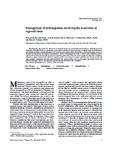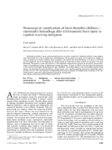Filters: Department: "Neurosurgery" Collection: "ir_uspace" School Or College: "School of Medicine" Format: "application/pdf"
| Creator | Title | Description | Subject | Date | ||
|---|---|---|---|---|---|---|
| 176 |
 |
Bisson, Erica F. | Management of distraction injury of the lumbosacral junction with unilateral perched facet | Background: Traumatic unilateral facet dislocation without fracture is an uncommon injury of the lumbosacral junction. We describe a case of a unilateral perched L5-S1 facet causing axial back pain and radiculopathy provoked by motion. ... | Spine surgery, Facet dislocation, operative management, trauma, neurosurgery | 2011-01-04 |
| 177 |
 |
Couldwell, William T. | Management of meningiomas involving the transverse or sigmoid sinus | Meningiomas that invade the transverse or sigmoid sinuses are uncommon tumors that are challenging to treat surgically. Although the risk of recurrence is associated with the extent of resection, complete removal of meningiomas in these locations must be balanced with avoidance of venous outflow obs... | 2013-01-01 | |
| 178 |
 |
Couldwell, William T. | Management of pituitary adenomas | We present an overview of the management of pituitary adenomas, with discussions of microanatomy, of diagnostic studies of general neuroendocrine function, and of radiologic evaluation. We discuss the diagnosis of pituitary adenoma and its treatment with sections on null cell, prolactin (PRL)-secre... | Pituitary adenoma; Transsphenoidal surgery; Corticotropin; Prolactin; Growth hormone; Transcranial surgery | 1994 |
| 179 |
 |
Kestle, John R. W. | Management of shunt infections: a multicenter pilot study | Object. Approximately 10% of cerebrospinal fluid (CSF) shunt operations are associated with infection and require removal or externalization of the shunt, in-hospital treatment with antibiotic agents, and insertion of a new shunt. In a previous survey, the authors identified substantial variation i... | Shunt infections; Ventriculoperitoneal shunt; Treatment evaluation | 2006 |
| 180 |
 |
Kestle, John R. W.; MacDonald, Joel D.; Schmidt, Richard H. | Marked reduction of cerebral vasospasm with lumbar drainage of cerebrospinal fluid after subarachnoid hemorrhage | Object. Cerebral vasospasm after subarachnoid hemorrhage (SAH) continues to be a major source of morbidity in patients despite significant clinical and basic science research. Efforts to prevent vasospasm by removing spasmogens from the subarachnoid space have produced mixed results. The authors hyp... | Cerebral vasospasm; Lumbar drainage | 2004 |
| 181 |
 |
Couldwell, William T. | Medical and surgical management of microprolactinoma | A recent report by Colao et al. [1] indicates that a significant proportion of patients harboring prolactinomas treated with cabergoline will have persistence of remission of hyperprolactinemia following withdrawal of the drug. The prolactin and tumor control rates in the study suggest that medical ... | Microprolactinoma; Prolactinoma; Cabergolene | 2004 |
| 182 |
 |
Schmidt, Meic H. | Medical applications of space light-emitting diode technology-space station and beyond | Space light-emitting diode (LED) technology has provided medicine with a new tool capable of delivering light deep into tissues of the body, at wavelengths which are biologically optimal for cancer treatment and wound healing. This LED technology has already flown on Space Shuttle missions, and show... | Photodynamic therapy; Lutetium Texaphyrin; Lutex; Canine glioma | 1999 |
| 183 |
 |
Couldwell, William T. | Medpor implant in cranioorbitomaxillary reconstruction: institutional experience and a review of the literature | Autologous materials remain the gold standard for complex skull base and craniofacial reconstruction, but they carry additional morbidity associated with the second harvest procedure and with prolonged operation time. These autologous materials also resorb in a way that is not predictable, rendering... | Medpor; Alloplastic material; Autogenous tissue; Craniofacial reconstruction; Skull base surgery; Methylmethacrylate; Silicone | 2008 |
| 184 |
 |
Couldwell, William T. | Metabolic syndrome: what neurosurgeons should know | The term metabolic syndrome, first introduced in 1988, has evolved in concept since that time. While the strict definition is subject to ongoing debate, the syndrome generally involves glucose intolerance, obesity, dyslipidemia and high blood pressure, which increase the risk of developing cardiovas... | 2008-01-01 | |
| 185 |
 |
Couldwell, William T. | Metastatic melanoma to the pituitary gland | Metastasis to the pituitary gland is unusual, and occurs most often in patients with carcinomas of the breast or lung. Despite its propensity for spread to the brain, metastatic melanoma has rarely been described within the sella. Methods: We report two cases of malignant melanoma pathologically co... | 2007 | |
| 186 |
 |
Schmidt, Meic H. | Minimally invasive thoracoscopic approach for anterior decompression and stabilization of metastatic spine disease | Object. The choices available in the management of metastatic spine disease are complex, and the role of surgical therapy is increasing. Recent studies have indicated that patients treated with direct surgical decompression and stabilization before radiation have better functional outcomes than thos... | Metastatic spine disease; Minimally invasive surgery; Spinal cord decompression | 2008 |
| 187 |
 |
Schmidt, Meic H. | Minimally invasive thoracoscopic resection of paraspinal neurogenic tumors: technical case report | OBJECTIVE: The posterior mediastinum is a common location for benign neurogenic tumors. They are frequently asymptomatic but can present with local compressive or neurological symptoms. METHODS: Thoracoscopy is used increasingly over posterolateral thoracotomy for the removal of these lesions. RES... | 2008-01-01 | |
| 188 |
 |
Dailey, Andrew T. | Modulation of macrophage and microglial responses to axonal injury in the peripheral and central nervous systems | OBJECTIVE: After axonal injury, macrophages rapidly infiltrate and become activated in the mammalian peripheral nervous system (PNS) but not the central nervous system (CNS). We used the dorsal root pathway to study factors that modulate the response of macrophages to degenerating axons in both the ... | Axonal injury; Macrophage response; Microglial response; Peripheral nervous system; Lewis rats | 1999 |
| 189 |
 |
Couldwell, William T.; Viskochil, David H.; Fults, Daniel Webster | Molecular, genetic, and cellular pathogenesis of neurofibromas and surgical implications | NEUROFIBROMATOSIS 1 (NF1) IS A common autosomal dominant disease characterized by complex and multicellular neurofibroma tumors. Significant advances have been made in the research of the cellular, genetic, and molecular biology of NF1. The NF1 gene was identified by positional cloning. The function... | Loss of heterozygosity; Malignant peripheral nerve sheath tumor; Plexiform Neurofibroma; Spinal neurofibroma | 2006 |
| 190 |
 |
Kestle, John R. W. | Moyamoya phenomenon after radiation for optic glioma | The role of radiotherapy in the management of patients with optic pathway glioma is controversial. In a series of patients with optic pathway glioma treated at The Hospital for Sick Children in Toronto, five children were encountered who developed moyamoya phenomenon after radiotherapy. A retrospec... | Optic pathway glioma | 1993 |
| 191 |
 |
Kestle, John R. W. | Multicenter prospective cohort study of the Strata valve for the management of hydrocephalus in pediatric patients | Object. Previous reports suggest that adjustable valves may improve the survival of cerebrospinal fluid shunts or relieve shunt-related symptoms. To evaluate these claims, the authors conducted a prospective multicenter cohort study of children who underwent placement of Strata valves. Methods. Pat... | Ventriculoperitoneal shunt; Strata valve; Adjustable valves; Pediatric neurosurgery | 2005 |
| 192 |
 |
Couldwell, William T. | Multifocal inflammatory leukoencephalopathy associated with levamisole and 5-fluorouracil: case report | LEVAMISOLE AND 5-FLUOROURACIL have now become the standard chemotherapeutic regimen for patients with Stage 111 colon carcinoma. A case of multifocal inflammatory leukoencephalopathy secondary to levamisole alone or combination of levamisole and 5-fluorouracil is reported. Magnetic resonance imaging... | Autopsy; Levamisole; Multifocal inflammatory leukoencephalopathy | 1994 |
| 193 |
 |
Schmidt, Meic H. | NASA light-emitting diode medical program-progress in space flight and terrestrial applications | This work is supported and managed through the NASA Marshall Space Flight Center - SBIR Program. Studies on cells exposed to microgravity and hypergravity indicate that human cells need gravity to stimulate cell growth. As the gravitational force increases or decreases, the cell function responds in... | Terrestrial applications; Cell growth; NASA; Microgravity environment | 2000 |
| 194 |
 |
Kestle, John R. W. | Natural history of cerebral cavernous malformations | To determine the natural history of brain cavernous malformations, the authors entered patients referred to their center into a prospective registry between 1987 and 1993. All patients underwent magnetic resonance imaging, which showed the typical appearance of this lesion, and conservative manageme... | Cavernous malformation; Vascular malformation; Seizure | 1995 |
| 195 |
 |
Couldwell, William T.; Nelson, Don Harry | Nelson syndrome: historical perspectives and current concepts | The appearance of an adrenocorticotropic hormone (ACTH)-producing tumor after bilateral adrenalectomy for Cushing disease was first described by Nelson in 1958. The syndrome that now bears his name was characterized by hyperpigmentation, a sellar mass, and increased plasma ACTH levels. The treatment... | 2007-01-01 | |
| 196 |
 |
Schmidt, Meic H.; Schmidt, Richard H. | Nerve sheath tumors involving the sacrum | Nerve sheath tumors that involve the sacrum are rare. Delayed presentation is common because of their slow-growing nature, the permissive surrounding anatomical environment, and nonspecific symptoms. Consequently, these tumors are usually of considerable size at the time of diagnosis. The authors di... | Nerve sheath tumor; Schwannoma | 2003 |
| 197 |
 |
Digre, Kathleen B.; Skuster, Denise Z. | Neurologic conditions presenting as psychiatric disorders. | Understanding underlying neuroanatomic function helps physicians to localize defects and search for treatable neurologic conditions. Neurologic conditions such as Huntington's chorea, Wilson's disease, Gille de la Tourette syndrome, brain tumors, encephalitis and meningitis, neurodegenerative condit... | Psychiatric Diagnosis; Neurologic Disease | 1992-06-15 |
| 198 |
 |
Garber, Sarah | Neurosurgical complications of direct thrombin inhibitors - catastrophic hemorrhage after mild traumatic brain injury in a patient receiving dabigatran | Dabigatran etexilate is an oral anticoagulant that acts as a direct, competitive thrombin inhibitor. Large randomized clinical trials have shown higher doses of dabigatran (150 mg taken twice daily) to be superior to warfarin in terms of stroke and systemic embolism rates in patients with nonvalvula... | 2012-01-01 | |
| 199 |
 |
Couldwell, William T. | Neurosurgical implications of allergic fungal sinusitis | Object. Allergic fungal sinusitis (AFS) is a form of paranasal mycosis that often involves bone destruction and extension into the orbit and anterior skull base. Treatment consists of surgical extirpation and a course of corticosteroids. Despite frequent intracranial involvement, AFS is rarely repor... | 2004 | |
| 200 |
 |
Couldwell, William T. | Neurosurgical workforce trends in the United States | Object. The purpose of this study was to evaluate the US neurosurgery workforce by reviewing journal recruitment advertisements published during the past 10 years. Methods. The number of available academic and private neurosurgical staff positions was determined based on recruitment advertisements ... | 2005-02 |
